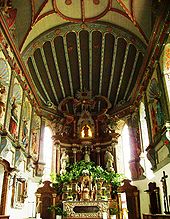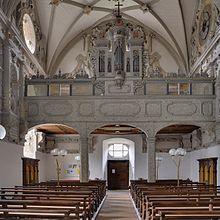St. Luzen Monastery Church
The St. Luzen monastery church is located in Hechingen in the Zollernalb district ( Baden-Württemberg ). Due to its uniform interior design, it is one of the most important architectural achievements of the late Renaissance in southern Germany.
location
A road leads to the church, which is lined with trees and stations of the cross . The end of the station path is the Calvary built in 1733 . It is a stone rotunda that encloses a grave chapel. On it stands a large crucifixion group, which the sculptor Johann Georg Weckenmann created in 1755. The entrance gate to the monastery district is right next to the Calvary.
Building history
A church consecrated to St. Lucius , the patron saint of the Diocese of Chur , was first mentioned in a document in 1318, and a nunnery in 1370. For 1390 it is documented that the nuns lived according to the rules of the Third Order of the Franciscans . These so-called Terziarinnen dedicated themselves collectively to the poor and sick.
Since (at least) 1328 the church of the women's monastery, which was dissolved in the 15th century, also served as the parish church for Hechingen until the parish was actually transferred to the collegiate church in 1488, formally in 1536 . After that, the church was neglected for decades, to Count Eitel Frederick I , the first ruler of Hohenzollern-Hechingen , his great-grandfather, the bequest Eitel Frederick II. Transposed into action: in 1586 he founded (up to secularization 1,803 existing) Franciscan monastery , the belonged to the Upper German (Strasbourg) order province of Argentina , and initiated a fundamental renovation of the Church of St. Luzen. The current building, completed in 1589, which took over the floor plan and parts of the outer walls from the Gothic predecessor church, embodies the colorful style of the late Renaissance in the interior. Around 1700 the church was redesigned in Baroque style to reflect the changing tastes of the time, the room was painted uniformly white and the altars were replaced. An extensive restoration from 1971 to 1975 restored the color version from 1589.
layout
The exterior looks very simple with its gray painted walls and the white structure. The architecture still shows a late Gothic influence. The abundant Renaissance stucco inside is unique in its cohesion and artistic maturity. Wendel Neufferer was in charge of the stucco work.
A stitch cap vault with gothic ribs extends over the single-nave, richly decorated interior . On the walls there are very artistic stucco decorations in roll and fittings . The entablature is supported by half-columns , in between there are flat shell niches with life-size figures of the apostles .
The choir with a three-eighth closure is covered in the western part by a ribbed vault and in the east by a large shell. The colorful painting was created by Hans de Bay , who lives in Riedlingen and is probably from the Netherlands .
Furnishing
The title saints of the seven Roman station churches stand in the choir . The stigmatization of St. Francis is depicted above the choir arch . The pulpit was made by Hans Amann in 1589 .
In the Antonius Chapel attached to the south side of the nave, a bronze tombstone (1609) covers the heart of Count Eitel Friedrich IV. It bears the inscription: “Ubi thesaurus meus, ibi cor meum” (“Where my treasure lies, there my heart rests”; cf. . Lk 12,34 EU ).
The altarpiece in the Antonius Chapel was painted by Johann Baptist Enderle in 1757 . The main altar (1743) and side altars (1702) date from the Baroque period, but use some older parts.
organ
The first organ was built in 1589 by the organ builder Conrad Beckh (Erfurt). In 1713 the organ was replaced by a new one built by Urban Reitter (Hayingen). At the same time, the instrument was moved to the newly built gallery. The organ was last restored in 1975. The slider chests -instrument has nine register on a manual and pedal and mean- tuned. The actions are mechanical.
|
|
|||||||||||||||||||||||||||||||||||
- Pairing : I / P
Baroque nativity scene
A large nativity scene is set up in the choir room from Christmas to the end of January . It's not just their size that is big, the figures are big too. The wooden jointed dolls are between 60 cm and 94 cm high. Such large-figured cribs were particularly preferred by the Jesuits from the 16th century onwards. Although there was never a Jesuit branch in Hechingen, there could have been connections and contacts, for example to the Jesuit college in nearby Rottenburg or to Mindelheim. The crib figures of the Mindelheim Jesuit Church and the St. Lucerne Church are strikingly similar. The crib was first mentioned in a document in 1819 in an inventory of the monastery.
Before the renovation of the crib in 1985, it was set up in the Antonius chapel on the side as a changing crib. Meanwhile, the angels, St. Family, the shepherds with their wives, the kings with their servants and the animals all set up in the choir of the church.
literature
- Margret Fecker, Gerhard Fecker: St. Luzen, Hechingen: former monastery church . Kunstverlag Peda, Passau 2003 - ISBN 3-89643-218-4
- Friedrich Hossfeld, Hans Vogel: The art monuments of Hohenzollern, first volume: Hechingen district . Holzinger, Hechingen 1939, p. 165 ff.
- Ruthild Mangler: The crib of St. Luzen in Hechingen in: Hohenzollerische Heimat No. 4/2007, Sigmaringen.
- Ruthild Mangler, Gregor Peda (photographs): The cribs of the St. Luzenkirche in Hechingen . Art publisher Peda, Passau 2015
- Hans-Jörg Mauser , Rudolf Schatz (ed.): Sankt Luzen in Hechingen . Theiss, Stuttgart 1991
- Wolfram Noeske: The St. Luzen monastery church in Hechingen is open again. In: Denkmalpflege in Baden-Württemberg , 5th year 1976, issue 1, pp. 1–10 ( PDF ) [not evaluated]
Individual evidence
Web links
- Franciscan monastery St. Luzen in the database of monasteries in Baden-Württemberg of the Baden-Württemberg State Archives
Coordinates: 48 ° 21 '28.88 " N , 8 ° 58' 17.57" E





